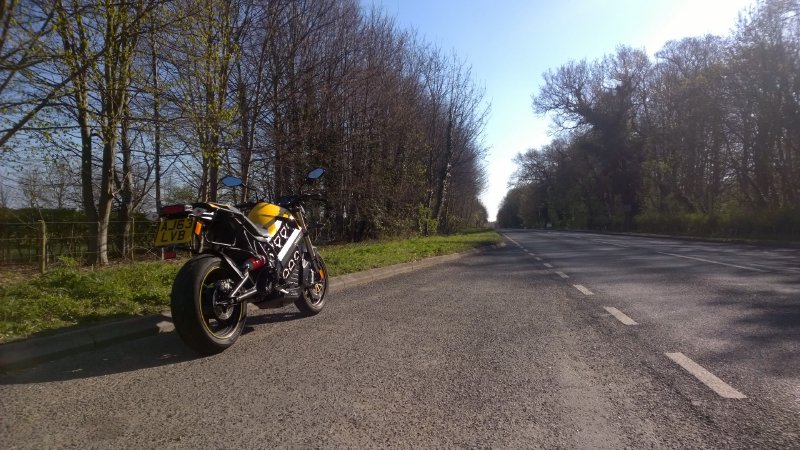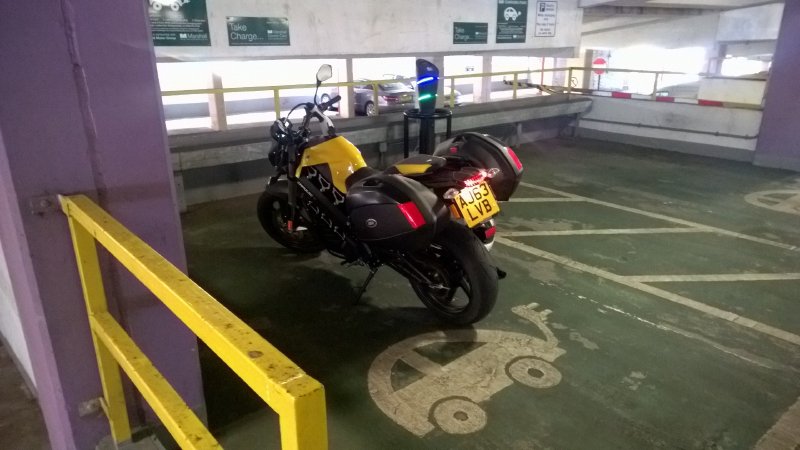1000 miles of electric motorcycling
The weekend before christmas in 2013 I had a few hours to kill before heading towards San Francisco International Airport to catch the flight back home after a week of work in the valley. On a whim, I headed to Scuderia Motorbikes in the mission, and asked if I might test drive a Brammo Empulse electric motorbike, not seriously thinking they would let a Brit with no chance of buying one from them do so. They did, and I loved it, thus entered a year of pain trying to acquire one; something I think my friends still derive amusement from. But back at the start of this year, a staggering thirteen months later, I had my Empulse R on the road. People keep asking me what I think of it, and now I’ve put some substantial miles on it I thought I’d write up what owning what was the best off the peg electric motorbike money could buy has been like.

Why the Brammo Empulse R?
Why this bike, when I could have much more quickly have gotten something else? It’s because when I test drive the Empulse R, it was everything I love about motorbikes, and a chance to partake in the future. Before the Empulse, I’ve always ridden v-twin bikes, an engine layout noted for high torque. I’ve driven some wonderful inline three and four cylinder bikes that just left me cold, as whilst they were much smoother and probably faster than my beloved v-twins, they didn’t have that grin inducing pull off the line. Like v-twins, electric motors are similarly known for their torque delivery, so there’s little surprise that initial test drive appealed to me.
The other reason was, drivetrain aside, the Empulse R is just a bloody good bike. It has high end suspension and brakes, it has a clutch operated gearbox, just like any other bike. There wasn’t any compromises when driving it compared to a regular bike. I’d test drive an early Zero Motorbike, and it was like driving a moped rather than a “real” motorbike (though I gather the newer Zero models are much more accomplished now).
Thus why: it was a novel thing, it rode well, it made me smile. Thus also why it is sad that, now I write this, you can no longer buy them. Brammo has been absorbed into its parent company Polaris as an R&D division, and the Empulse is no longer for sale.
So, what’s it like to ride?
In a word, joyful.
The ride: this is the best of both worlds as far as I’m concerned: it has the torque of the v-twin that I so love, but doesn’t have the associated agricultural levels of vibration associated with such an engine configuration. Indeed, there’s no engine vibration at all.
The bike is quite heavy for its small stature – batteries being quite dense – but in motion that weight vanishes. It’s quick off the line due to the electric motor being able to pull immediately. In cornering, the bike is very quick to turn in, and once you have it over, it’s really easy to adjust thanks to the stability from not having that vibrating engine. It’s a really easy bike to drive. It makes my Buell, which is actually quite an agile bike itself thanks to a very low centre of gravity, seem sluggish in comparison.
In both regular and sports modes the bike is very well behaved, but in sport mode if you twist the trottle hard, the bike launches itself forward at a rate I’ve not experienced since I last rode a Ducati 996. Overtakes are executed in the blink of an eye, and an open road means leaving whatever was behind you far behind. But at the same time, two up and in regular drive, it’s a very sedate usable bike.
Top end, the motor starts to struggle a little if you push it much above average motorway speeds, so perhaps not an ideal trackday weapon, but that suits me fine; I like my bikes to be fun at legal speeds, and here the Brammo delivers in spades.
So, what’s it like as an EV?
The range will vary highly depending on how you drive it, but there’s no getting away from the fact that compared to a petrol bike here you are more limited. A full charge will take 3 hours or so, and that’ll get you 70 miles if you keep the speed at or below 60. I imagine though if you were driving 70+ continuously you’d see your range dip south of 50 (though I’ve not yet put that to the test).

But that said, for a weekend run around the countryside, this works quite well, particularly in two up where you naturally are given to drive more smoothly. If you want a protracted race around your local run, well you’ll find yourself potentially frustrated compared to a petrol driven sports bike.
I’ve found that if I want to get the most out of the range (I’ve done a couple of “how far could I go reasonably” trips to see what I could get) you basically want to drive at the speed limit until around 40, then you stick ten below, which will minimise annoying people too much, still be enjoyable to ride, but get a top range.
All that said for most trips, given I know the range now, I don’t have anxiety about it any more. It is what it is, and I know I’ll not be driving this up to Scotland any time soon. If I know I’m not going too far I’ll enjoy the bikes capabilities to the full, if I’m going further afield then I’ll take a more sedate pace. I had hoped it’d be better based on initial figures from the Brammo website, but with the reduced range I’m still not letting that stop me using this bike more than the Buell.
What else?
Owning the Brammo has not been a pain free experience, but a lot of that is down to being an early adopter of a vehicle with limited availability and no base of operations in your country, so I don’t want to get into those, they don’t do the engineering itself justice. I want to look forward to a world where those issues go away as more people have bikes like this. So what would I improve on the Brammo if I have the chance?
First up, the speedo on the dash is a little annoying at motorway speeds, becoming hard to read. They have a LCD panel with faux seven segment display numbers that flicker around, and because LCDs have refresh lag, the numbers blur into each other making it hard to tell if you’re at sixty or seventy or what (I assume this is less of an issue in the US as their limits are 55/65, so the top digit will be more stable). Thankfully I have an alternative solution on order.
The bike uses a chain drive, which after using a maintenance free belt drive on the Buell feels like a step backwards. Most automatic chain oilers rely on a conventional engine to work, or are very expensive electronic ones, but thankfully someone on the Brammo owners forum recommended a clever little unit from Tutoro that works based on road bumps moving a ball bearing, and in Cambridgeshire we’re not short of bumps in the road.
Finally, the bike takes a type-1 charge socket, and in the UK life seems easier if you have a type-2 charge socket. This isn’t a major issue, and I’ve successfully charged the bike whilst out and about, but does mean I can’t use the charge points common at UK motorway service stations.
Summary
Early adopter issues aside, I really do enjoy this bike an awful lot. Yes, the range could be better, but I knew that going into the purchase I’d not be going around the continent on this bike (at least, not without a lot of logistical forethought). But to drive, it’s such a lovely experience. It drives like a conventional bike from a control point of view, but with this unconventional blend of lots of torque whilst being buttery smooth at all times. There’s just no bike like it out there at the moment, and I do hope that Polaris (who now own Brammo, and also own the Victory and Indian bike brands) put something else out in the near future. The signs are at least positive – Victory are racing a Brammo derived bike in this year’s electric TT.
- Next: Punting
- Previous: Charging together
- Tags: Brammo, Empulse, Geek, Motorcycling